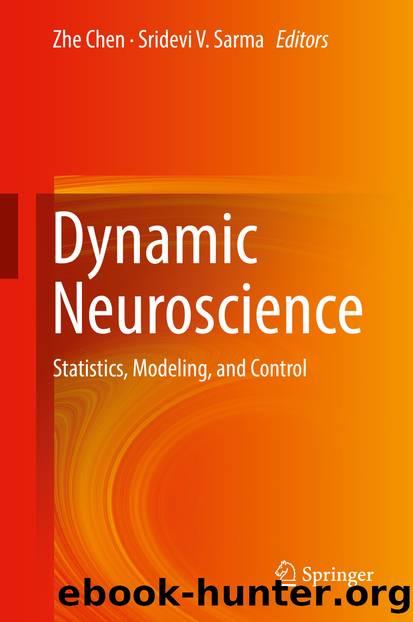Dynamic Neuroscience by Zhe Chen & Sridevi V. Sarma

Author:Zhe Chen & Sridevi V. Sarma
Language: eng
Format: epub
Publisher: Springer International Publishing, Cham
2.Detect bad electrodes from EEGtemp based on the maximum correlation coefficient and add them to the bad electrode list;
3.EEGtemp = EEGââmean(EEG), where mean(EEG) is the mean of the EEG with all the bad electrodes interpolated;
4.Repeat steps 2â3 until the bad electrode list does not change.
5.Reject and interpolate the bad electrodes in EEG;
6.EEG = EEGââmean(EEG).
The maximum correlation criterion can only identify single noisy electrodes not resembling any other electrodes. However, in some situations a local cluster of electrodes may become artifactual together in which case electrode correlations will be high within each cluster. To address this issue, the random consensus (RANSAC) method is employed to detect noisy clusters of electrodes following the maximum correlation criterion (Bigdely-Shamlo et al. 2015). More specifically, RANSAC uses a random subset (25% by default) of electrodes to predict the EEG of each electrode (excluded from the subset) in each epoch. The prediction is repeated 50 times. The correlation coefficients of the predicted EEGs and the actual EEG of each electrode are then calculated. An electrode is bad if the 50 percentile of the correlation coefficients is less than a threshold (0.75 by default) on more than a certain fraction of epochs (0.4 by default).
Download
This site does not store any files on its server. We only index and link to content provided by other sites. Please contact the content providers to delete copyright contents if any and email us, we'll remove relevant links or contents immediately.
Exploring Deepfakes by Bryan Lyon and Matt Tora(8256)
Robo-Advisor with Python by Aki Ranin(8226)
Offensive Shellcode from Scratch by Rishalin Pillay(6375)
Microsoft 365 and SharePoint Online Cookbook by Gaurav Mahajan Sudeep Ghatak Nate Chamberlain Scott Brewster(5600)
Ego Is the Enemy by Ryan Holiday(5292)
Management Strategies for the Cloud Revolution: How Cloud Computing Is Transforming Business and Why You Can't Afford to Be Left Behind by Charles Babcock(4524)
Python for ArcGIS Pro by Silas Toms Bill Parker(4448)
Elevating React Web Development with Gatsby by Samuel Larsen-Disney(4169)
Machine Learning at Scale with H2O by Gregory Keys | David Whiting(4169)
Liar's Poker by Michael Lewis(3367)
Learning C# by Developing Games with Unity 2021 by Harrison Ferrone(3333)
Speed Up Your Python with Rust by Maxwell Flitton(3277)
OPNsense Beginner to Professional by Julio Cesar Bueno de Camargo(3249)
Extreme DAX by Michiel Rozema & Henk Vlootman(3234)
Agile Security Operations by Hinne Hettema(3160)
Linux Command Line and Shell Scripting Techniques by Vedran Dakic and Jasmin Redzepagic(3148)
Essential Cryptography for JavaScript Developers by Alessandro Segala(3117)
Cryptography Algorithms by Massimo Bertaccini(3054)
AI-Powered Commerce by Andy Pandharikar & Frederik Bussler(3021)
